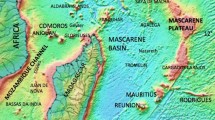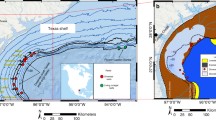Abstract.
The sedimentological and chronological study of Holocene reef sequences recovered in drill cores through modern reefs of Mauritius, Réunion Island and Mayotte allows the reconstruction of sea level changes and reef growth patterns during the Holocene. The branching-coral facies systematically predominates over coral head facies throughout the Holocene reef sequences, and Acropora is the main frame builder among the branching forms. The reconstructed sea level curves, based both on identification of coral assemblages and on radiometric U/Th ages, are characterized by a rapid rise between 10 and 7.5 ky BP, followed by a clear inflection between 7.5 and 7 ky BP. The stabilization of sea level at its present level occurred between 2000 and 3000 years ago, probably without a higher sea level stand. Rates of vertical reef accretion range between 0.9 and 7 mm. y-1. In Mauritius, and also probably in Réunion Island, the reef first tracked, then caught-up to sea level to reach an equilibrium position (“catch-up” growth), while the barrier reef margin off Mayotte has been able to keep pace with rising sea level (“keep-up” growth).
Similar content being viewed by others
Author information
Authors and Affiliations
Additional information
Accepted: 1 March 1997
Rights and permissions
About this article
Cite this article
Camoin, G., Colonna, M., Montaggioni, L. et al. Holocene sea level changes and reef development in the southwestern Indian Ocean. Coral Reefs 16, 247–259 (1997). https://doi.org/10.1007/s003380050080
Issue Date:
DOI: https://doi.org/10.1007/s003380050080




